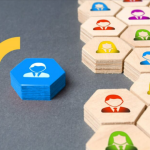Marketing to everyone in the same way doesn’t work anymore. With so much customer information available, it’s hard to know how to use it to reach the right people. Without properly grouping customers, marketing can become too general, wasting time and effort without getting the results you need.
This is why audience data management is essential, as it helps you collect and collate customer information from multiple sources. An audience data platform is essential to collate all that information into one location to help you understand your customers.
The solution is customer segmentation. By grouping people based on shared traits and behaviors, you can create more personalized marketing that speaks directly to them. Using the right tools, you can easily organize customer data, helping you send the right message to the right people at the right time.
Simple Customer Segmentation Models to Grow Your Business
Here are eight simple yet powerful customer segmentation models. Each one helps you group your customers based on different traits
1. Demographic Segmentation
Demographic segmentation involves identifying customers according to categories such as:
- Age
- Gender
- Income
- Education
- Marital status
Demographic segmentation is one of the most used models by marketing, customer service, and research teams. You may use demographic segmentation in multiple ways, for example:
- Use different outreach methods to identify different age group audiences.
- Target individuals interested in higher education based on their education level.
- Develop offers for price-conscious customers based on their income.
2. Behavioral Segmentation
Behavioral segmentation allows you to categorize people based on how they engage with your brand. For example:
- Their buying patterns
- How they use your products
- Whether they shop online or in-store
Using behavioral segmentation may give you an idea about customers to create personalized advertisements. This could also assist your customer service team by pre-empting frequently asked questions by visiting a help desk or FAQ page.
3. Psychographic Segmentation
Psychographic segmentation advances the understanding of your customers, as it evaluates your customers’ feelings, values, interests, and lifestyles. A psychographic segmentation model may include:
- Personal values
- Interests
- Opinions
- Personality traits
Particularly by sharing offers that match customers’ values, i.e., selling eco-friendly products; personal stories about products that may ignite a customer’s emotional side; and recognizing shared interests with customers (i.e., books) to market similar products.
4. Value-Based Segmentation
Value-based segmentation sorts customers by the value they bring to your business. This involves:
- How often they buy
- How much they spend
- The lifetime value of each customer
This model helps you focus on your most valuable customers, offering them rewards or exclusive deals to keep them engaged.
5. Geographic Segmentation
Geographic segmentation divides customers based on their location, such as:
- Country
- City
- Region
Understanding where your customers are located allows you to:
- Send localized messages or celebrate regional events.
- Use local slang or references to appeal to them.
- Identify opportunities for expanding to new areas.
6. Technographic Segmentation
Technographic segmentation focuses on your customers’ technology habits. You can understand this by:
- Surveying your customers
- Analyzing how they access your website
- Identifying the types of devices they use
This can help you decide whether to launch a mobile app, improve your website for different devices, or develop simpler products for less tech-savvy users.
7. Needs-Based Segmentation
Needs-based segmentation identifies customers based on their specific needs or problems. For example:
- If customers have delivery issues, like food arriving too late, adjusting delivery times can improve service.
- Some customers may need better accessibility features, like text-to-speech or image descriptions.
This model helps you better serve your customers by focusing on their needs and challenges.
8. Lifecycle Stage Segmentation
Lifecycle stage segmentation divides customers based on where they are in their journey with your brand. These stages include:
- Prospects
- New customers
- Loyal customers
By tracking where each customer is in their journey, you can:
- Tailor your approach for new customers.
- Find ways to engage loyal customers.
- Improve onboarding for customers just starting with your brand.
How Audience Data Management and an Audience Data Platform Help You Segment Smarter?
To make customer segmentation work well, you need the right data in one place. That’s where audience data management and an audience data platform come in.
Audience data management is the process of collecting, organizing, and keeping track of customer information from different sources—like your website, social media, emails, or in-store purchases. It helps you understand who your customers are, what they like, and how they behave.
An audience data platform is a tool that brings all this customer information together in one place. It allows you to create clear customer groups using the segmentation models we talked about—like age, behavior, interests, and more.
With audience data management, businesses can connect and analyze data faster, allowing for smarter marketing choices.
Using an audience data platform, you can easily:
- Create better marketing campaigns
- Send the right messages to the right people
- Improve customer experience
- Track how customers move through the buying journey
In short, these tools make it easier to understand your audience and make smarter business decisions.
Bottom Line
Customer needs keep changing, and marketing to everyone the same way no longer works. That’s why customer segmentation is so important. It helps you understand your audience and talk to them in a way that matters.
With the help of audience data management and an audience data platform, you can collect all your customer information in one place, group your audience better, and send the right message to the right people.
As your business grows, these tools will help you stay ready for the future. The more you know your customers, the easier it is to keep them happy and loyal.
Lynn Martelli is an editor at Readability. She received her MFA in Creative Writing from Antioch University and has worked as an editor for over 10 years. Lynn has edited a wide variety of books, including fiction, non-fiction, memoirs, and more. In her free time, Lynn enjoys reading, writing, and spending time with her family and friends.















